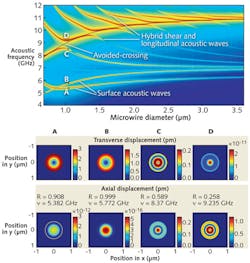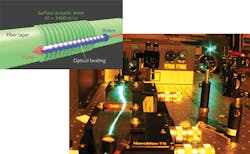Specialty Fibers: Ultrathin optical fibers and surface acoustics make tiny sensors possible
THIBAUT SYLVESTRE and JEAN-CHARLES BEUGNOT
Subwavelength-diameter optical fibers—also known as optical microfibers, microwires, or nanowires—are the tiny cousins of standard optical fibers.1,2 These hair-like slivers of glass, manufactured by tapering optical fibers down to a size 100 times smaller than a strand of hair, have a number of optical and mechanical properties that make them very attractive for both fundamental physics and technological applications.
In addition to providing strong light confinement and enhanced nonlinear optical effects, optical microwires also exhibit a large evanescent field, enabling applications not currently possible with comparatively bulky optical fibers. And although microfibers can greatly enhance the optical Kerr effect and stimulated Raman scattering for supercontinuum generation, Brillouin scattering in these tiny waveguides has yet to be explored.3
By confining light in silica optical microfibers 50 times thinner than a human hair, our group at the CNRS Femto-ST Institute in Besançon, France, in collaboration with colleagues at the Institut d'Optique in Paris, has observed for the first time a new type of Brillouin light scattering from surface acoustic waves. This phenomenon, which varies according to the fiber's environment, can be used to develop low-cost optical diffusers and innovative, highly sensitive optical sensors that target new applications.
Scattering light from sound
Brillouin scattering is one of the most important nonlinear optical processes in optical fibers and results from the coherent interaction between light and acoustic waves. It has important applications ranging from optical sensors to telecommunications and also enables slow and fast light propagation. In standard optical fibers, light excites and interacts with shear and longitudinal bulk elastic waves, giving rise to well-known physical effects such as forward-guided acoustic wave Brillouin scattering (GAWBS) and backward-stimulated Brillouin scattering (SBS).4,5
In a subwavelength-diameter optical fiber, we recently reported the first experimental observation of Brillouin light scattering from surface acoustic waves.6 To observe these waves, we injected a laser beam into a 1 μm diameter silica fiber wire. As the beam travels down the fiber, it induces infinitesimal vibrations in the wire through the electrostrictive optical force, displacing the surface by a few nanometers.
The distortions lead to surface acoustic waves that travel along the wire surface at 3400 m/s. These acoustic phonons in turn affect the light propagation, that is, a part of the light is backscattered with a slight shift of its carrier frequency due to the Doppler effect. This frequency shift is on the order of 5–6 GHz, far from the standard Brillouin frequency shift of standard optical fibers (about 11 GHz).
The silica microwires used in our experiment were fabricated by our Institut d'Optique colleagues by heating and stretching standard single-mode optical fibers (measuring 125 μm in diameter) down to a diameter of 1 μm over a length of 8 cm (see Fig. 2). In our lab at the Femto-ST Institute, we configured the experimental setup to detect the acoustic waves.Our pump source was a narrow-linewidth continuous-wave distributed feedback (DFB) laser operating at 1550 nm. The laser output was split into two beams using a fiber coupler. One beam was amplified and injected in the optical microwire through an optical circulator, while the other beam was used for detection via a heterodyne technique in which the backscattered light from the microwire was mixed with the input coming from a second fiber coupler. The resulting beat note was then detected using a fast photodiode and its Brillouin spectrum was recorded using an electrical spectrum analyzer.
For an input power of 100 mW, the resulting experimental spectrum displays the clear emergence of several frequency peaks with different weights in a radio-frequency range from 6 to 11 GHz. First, the high frequency at 10.86 GHz originates from standard Brillouin scattering in the untapered fiber sections. More importantly, two other peaks appear around 6 GHz that result from Brillouin scattering from surface waves, whereas the three other resonances around 9 GHz are clearly the signature of hybrid shear and longitudinal acoustic waves.
Simulations
Our observations were subsequently confirmed through numerical simulation using the elastodynamic wave equation including the optical force, which shows the computed sound density generated by light in the silica microwire as a function of frequency and wire diameter (see Fig. 2).6 As shown in the simulation, we retrieve most of the surface and hybrid acoustic resonances around 6 and 9 GHz.
The simulations and experiments also confirm that, for a given microwire diameter, multiple hybrid waves with widely spaced frequencies can be simultaneously excited. This means that in such small subwavelength waveguides, the light-sound interaction is fundamentally different from standard optical fibers. In other words, the Brillouin spectrum is not simply the signature of a single bulk longitudinal sound wave.
Instead, in such tiny waveguides, waveguide boundary conditions induce a strong coupling of shear and longitudinal displacements, resulting in much richer dynamics of light interaction with sound. In fact, the hybrid waves are not orthogonal and thus strongly interact with associated transverse and axial displacements in the microwire for four of the surface and hybrid modes.
As an example, a surface acoustic mode at 5.382 GHz exhibits a transversal displacement of a few picometers and a weak axial displacement just below the wire surface. Clearly, this is the signature of a surface Rayleigh wave that combines both a longitudinal and transverse motion to create mechanical ripples with an elliptic orbit motion (see Fig. 3).Sensing applications
In standard optical fibers, light travels essentially within the 10 μm diameter core of the fiber and thus does not generate surface waves. But when light is confined in a subwavelength-diameter waveguide, our research confirms the first reported observation of surface acoustic wave Brillouin scattering (SAWBS). This SAWBS effect is significant in that it may foster the investigation of such surface waves in many different photonic platforms, including photonic crystal fibers and integrated silicon or chalcogenide photonic chips.
Since the waves generated by the confinement of the light travel along the surface, they are sensitive to environmental factors such as temperature, pressure, and ambient gas. This makes it possible to design highly sensitive and compact optical sensors for industrial and scientific applications.
Our investigations also help improve knowledge of the fundamental interaction between light and sound on an infinitesimally small scale. Surface Brillouin scattering also opens new opportunities in other domains such as nonlinear plasmonics. For instance, one could expect a strong interaction between surface waves and surface plasmons by depositing a thin layer of gold or silver on the microwire surface.
REFERENCES
1. L. Tong et al., Nature 426, 816–819 (2003).
2. G. Brambilla, J. Optics 12, 4, 043001 (2010).
3. M. A. Foster et al., Opt. Express 16, 2, 1300–1320 (2008).
4. R. M. Shelby et al., Phys. Rev. B 31, 5244–5252 (1985).
5. E. Ippen and R. Stolen, Appl. Phys. Lett. 21, 11, 539–541 (1972).
6. J. C. Beugnot et al., Nat. Commun. 5, 5242 (2014).
Thibaut Sylvestre and Jean-Charles Beugnot are French National Research Center (CNRS) researchers at the FEMTO-ST institute, University of Franche-Comté, 15B avenue des Montboucons, 25030 Besançon, France; email: [email protected]; http://www.femto-st.fr.


